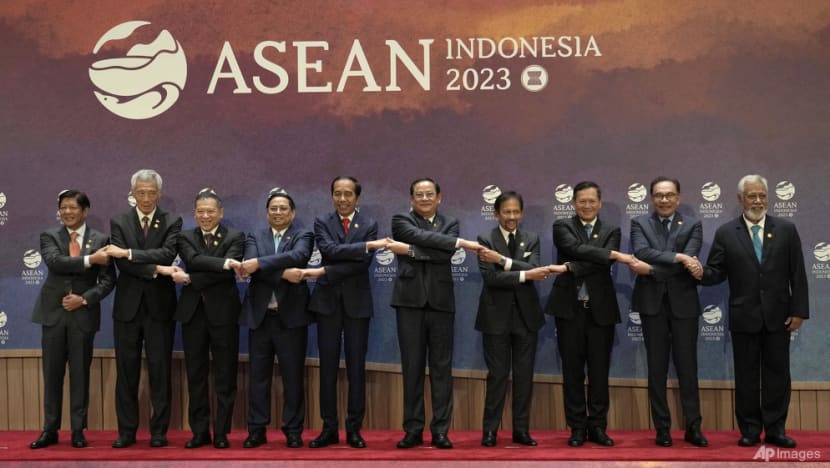Commentary: The plea for ASEAN to pull its weight is now a constant refrain
ASEAN is at a critical juncture amid the Myanmar crisis, heightened tensions in the region and a fast-entrenching Indo-Pacific framework, says Tan See Seng of the S Rajaratnam School of International Studies.

SINGAPORE: At the Association of Southeast Asian Nations (ASEAN) Summit in Jakarta on Sep 5, Singapore Prime Minister Lee Hsien Loong spoke impassionedly about ASEAN’s need for “unity of purpose and action” in dealing with challenges both external and internal.
Acknowledging the different - even divergent - interests and positions among ASEAN member states on pressing geopolitical concerns, Mr Lee urged his fellow leaders to collectively “work towards common landing points”, a process likely to require “some give and take” between and among themselves.
Mr Lee’s plea comes at a critical juncture amid ASEAN’s ongoing Myanmar imbroglio, heightened tensions in the region and a fast-entrenching Indo-Pacific infrastructure that, if left unattended, could sideline ASEAN in regional affairs.
It also signals concern over ASEAN’s fortunes as the bloc transitions from the strong leadership of outgoing chair Indonesia to a potentially weak tenure of incoming chair Laos.
GOOD ISN’T ENOUGH
To seasoned observers of ASEAN, Mr Lee’s plea for institutional unity and proactivity - the key to ensuring ASEAN’s continued relevance in an increasingly fraught Indo-Pacific - is a refrain that has become commonplace, often for the wrong reasons.
While ASEAN’s intramural diplomacy has kept the peace among its member states for more than five decades, that same model of decision-by-consensus and non-interference on which ASEAN has continually relied limits the bloc’s ability, when needed, to positively impact the internal affairs of its member countries.
With the right conditions, ASEAN’s brand of moral suasion works wonderfully - as it did in 2008, when ASEAN ably convinced the junta ruling Myanmar then to open its doors to international aid, following the devastation wrought to the country by Cyclone Nargis.
However, faced with an obdurate leadership in Naypyidaw today and hobbled by disunity within its own ranks, ASEAN has failed to bring the current ruling junta in line with the Five-Point Consensus agreed upon by ASEAN and junta leader Min Aung Hlaing back in April 2021.
Externally, despite assurances given at the ASEAN Summit from United States Vice President Kamala Harris and Chinese Premier Li Qiang about their respective countries’ support for ASEAN, the US-China rivalry has intensified to a point where Southeast Asian nations feel compelled to choose sides - something they would rather avoid.
Furthermore, ASEAN has been at pains to argue its relevance to the Indo-Pacific, the lens through which foreign policymakers now view Asia.
In recent years, policy frameworks like China’s Belt and Road Initiative and the US-backed Quad, AUKUS and Indo-Pacific Economic Framework for Prosperity have proliferated. These arrangements are seen by some as rival architectures to ASEAN-led ones, which threaten to diminish ASEAN’s vaunted “centrality” in regional affairs.
TIME TO STEP UP
Against that difficult backdrop, ASEAN needs to step up or risk losing it all. As a region in flux, the Indo-Pacific offers opportunities that ASEAN could seize.
Granted, US-China relations are likely to worsen. China also angered the region anew with its latest national map, which lays claims from the Himalayas to the South China Sea. The offending map has elicited objections from India, Malaysia, Philippines, Taiwan and Vietnam - all of which have territorial disputes with China.
Yet it remains uncertain whether, given its current economic woes, a weaker China will continue bossing the ASEAN region with its divide-and-rule tactics. Nor is it clear whether China’s slowdown, which is expected to negatively impact Southeast Asia, may relax Beijing’s economic hold on the region enough to encourage countries like Cambodia and Laos to ease up on their strong pro-China stances.
If ASEAN is to “be the captain of (its) own ship”, as Indonesian President Joko Widodo emphasised when handing the reins to ASEAN over to his Laotian counterpart Sonexay Siphandone, a Laos that is less beholden to China could help.
In this respect, Laos’ consent to ASEAN’s decision to adopt a “troika” approach - comprising Laos, Indonesia and Malaysia in 2024 - to deal with Myanmar is a good sign that Vientiane seeks a collective solution to the crisis.
In calling his fellow leaders to foster greater unity, commonality and flexibility, Mr Lee is urging for an ASEAN that walks its talk of regional leadership - a privilege that can no longer be taken for granted as the region is being contested, redrawn and redefined by outsiders.
In his ASEAN address, Mr Lee spoke at length about the ASEAN Outlook on the Indo-Pacific, the bloc’s official rejoinder to the Indo-Pacific which makes a case for ASEAN playing “a central and strategic role” in the region. Yet there can be no case without the concerted conduct to back it up.
In a 2015 speech, the former Singaporean diplomat Bilahari Kausikan chastised academics for wrongly presuming - and expecting - ASEAN to behave as a “horse”, when it is but a “cow”.
Part of that is due to ASEAN’s penchant for “horse talk”. Cow or horse, it is time for ASEAN to pull its weight. It only has itself to blame if it fails.
Tan See Seng is the president and chief executive of International Students Inc in the United States and research adviser for the S Rajaratnam School of International Studies at Nanyang Technological University, Singapore.


















